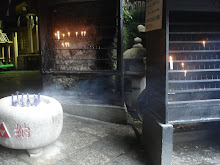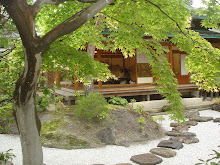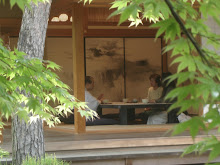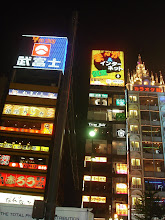Golden Gai is a warren of alleys that contains a precious grid of tightly wedged low 2-storey buildings - each and every one of them is a small or tiny bar. Golden Gai opens for business after nightfall. The premises may or may not be indicated by a small square neon sign. The bar might be big enough to seat five at the counter, or there may be standing room for twelve. Stairs as steep as those on a small boat take you the bars overhead. Customers and the bartender are more intimate than family, they laugh together as friends.
Golden Gai is an odd island: to land there you have to navigate your way down tall Shinjuku blocks with a nose for where the district might lie and you must keep a sharp eye out for an unmarked narrow alley that will take you in on the west or via another on the south side. Or you might wander through the eerie darkness of the large Hanazono Shrine, its avenue of red Tori gates, random altars, its balcony of steps and various statues of foxes, (revered as kami - divine spirits), will gaze at your trespass. If you can keep the faith and cross through the compound you might be able to stumble on the alley that runs down the east of Golden Gai.
Once you are there you will be almost surrounded by the cliffs of the backs of tall city blocks but you will be free to patrol up and down the cocoon of alleys and wonder what it would be like to belong to one of the bars.
Friday, May 23
Monday, May 12
Learning Japanese: Word/World Power
The day did not start out well. I had gone to the bookstore to pick up my Hanko - my official Japanese name stamp. I need it to verify all official documents and I have to have it in order to set up a bank account. My Hanko looked cool - a neat and slender black lacquer stamp. I also bought the mandatory red ink pad - in a small black case - I had a little black drawstring bag to carry them. I went to my office and tried out my new Hanko - marking a page with neat red squares containing my name in Katakana script.
Katakana is one of 3 Japanese scripts - it is used exclusively to spell out foreign words. Kanji is their highest order script - it's a system of pictorial ideograms used to symbolise words and concepts, you need to know at least 4,000 of these symbols to make sense of a Japanese newspaper. A basic Japanese education involves learning 20,000 Kanji. Hiragana is the Japanese script that is used to modify Kanji in various ways - it is syllabic - more like our idea of an alphabet.
I slowly worked out what the Katakana symbols of my Hanko spelt: o - ton -ru: it dawned on me that my lovely O'Donnell surname had been rendered -o-ton-ru. I was surprised how disappointed I was. Jonathan Swift knew about Japan (largely from enjoying the outrageous travel writings of a bogus fraud) and I suspect he had a good swipe at the Kanji system in Gulliver's Travels - where fellows carry ever-expanding loads of symbols that they pull out from backpacks in order to make themselves understood. It's always a bad day for me when I feel an affinity with Swift. I could feel a curious indignant pitch rise in me - call it tribal - I wished I had let whoever had done this know that they might have forgotten Katakana and given me Kanji symbols - O'Donnell is from Domhan Ail - picture World Power please.
Katakana is one of 3 Japanese scripts - it is used exclusively to spell out foreign words. Kanji is their highest order script - it's a system of pictorial ideograms used to symbolise words and concepts, you need to know at least 4,000 of these symbols to make sense of a Japanese newspaper. A basic Japanese education involves learning 20,000 Kanji. Hiragana is the Japanese script that is used to modify Kanji in various ways - it is syllabic - more like our idea of an alphabet.
I slowly worked out what the Katakana symbols of my Hanko spelt: o - ton -ru: it dawned on me that my lovely O'Donnell surname had been rendered -o-ton-ru. I was surprised how disappointed I was. Jonathan Swift knew about Japan (largely from enjoying the outrageous travel writings of a bogus fraud) and I suspect he had a good swipe at the Kanji system in Gulliver's Travels - where fellows carry ever-expanding loads of symbols that they pull out from backpacks in order to make themselves understood. It's always a bad day for me when I feel an affinity with Swift. I could feel a curious indignant pitch rise in me - call it tribal - I wished I had let whoever had done this know that they might have forgotten Katakana and given me Kanji symbols - O'Donnell is from Domhan Ail - picture World Power please.
Learning Japanese - Turning Japanese
I went back to the bookstore. I was at the counter where I had collected my Hanko. It is also the place where they sell stamps and photocopy cards and other stationary needs. My phrasebook was in my pocket. I had learned the phrase: 'Ki-te o ku-da-sai': 'Stamps please'. My plan was to hold up 4 fingers to signal that I wanted 4 stamps. I hadn't been able to figure out how to express the number 4. Japanese, like Irish, has a distinct counting system for people (duine, beirt, triur...) but Japanese is even more specific. Besides the number required or described there is another classifying word that must be added to the number. The classifying word is used to give an added precision and signals whether the object being counted is small, or long, or has a binding, or is an animal, or is a vehicle, or whether you can drink it or it eat it, or whether the number relates to an age, or the floor of a building, or the time - the list of classifications continue - .
More difficult still the classifcation word changes depending on the number - so the classification for long objects changes from hon to pon to bon (the classification for animals changes from hiki to piki to biki) according to the number required or described. It was too much of a challenge to figure out what 4 stamps might be - perhaps it might be 'yon-ko kite' but you can also use 'shi' instead of 'yon' to signal '4'. A colleague here had told me that a surprise best-selling book in Japan last year was a dictionary with lists of how to correctly count things - so obviously the Japanese themselves need assistance with doubt and potential confusion. I was just going to wave four fingers and say : 'Ki-te o ku-da-sai'.
I came to the hatch - there were three women working at their desks among stacks of stationary. 'Sumi-ma-sen' (excuse me) 'Ki-te o ku-da-sai'. The women looked up. 'Ki-te o ku-da-sai' -waving my fingers. They looked at each other. One of them stood up and approached. 'Hai' she said - which doesn't so much mean 'yes' as 'I understand' - because Japanese people never want to say no or even distrub the connection with a question - they will just say 'Hai'. 'Ki-te o ku-da-sai' -waving my fingers. We continued at this for a few more attempts - she had moved so close to me that she was staring up into my nostrils and remarkably, I could sense some irritation: I didn't think that Japanese people could get irritated. She was still saying 'Hai' I knew she was unhappy and I was backing away. I waved the envelopes. 'Kit TE!' she said. 'Hai' said I. 'How many?' she asked. 'Four'.
I ran through the scenario with my colleagues: what went wrong? They said - you were saying 'ki-te' - it means -'come here'. I practised Kit TE! a number of times. 'Good', they said. 'Phew', I said: 'Got it - Ke TE!' There was a silence - Hmm - no, you've just asked her to cut you something. 'And there would be nothing there for her to cut', one of my colleagues helpfully pointed out. 'ki-te' Kit TE! Ke TE! I was exasperated. They nodded in a friendly way. Then one suggested: 'Maybe you could ask for: "postage stamps please".' "Yes", they agreed. "Ask for postage stamps."
More difficult still the classifcation word changes depending on the number - so the classification for long objects changes from hon to pon to bon (the classification for animals changes from hiki to piki to biki) according to the number required or described. It was too much of a challenge to figure out what 4 stamps might be - perhaps it might be 'yon-ko kite' but you can also use 'shi' instead of 'yon' to signal '4'. A colleague here had told me that a surprise best-selling book in Japan last year was a dictionary with lists of how to correctly count things - so obviously the Japanese themselves need assistance with doubt and potential confusion. I was just going to wave four fingers and say : 'Ki-te o ku-da-sai'.
I came to the hatch - there were three women working at their desks among stacks of stationary. 'Sumi-ma-sen' (excuse me) 'Ki-te o ku-da-sai'. The women looked up. 'Ki-te o ku-da-sai' -waving my fingers. They looked at each other. One of them stood up and approached. 'Hai' she said - which doesn't so much mean 'yes' as 'I understand' - because Japanese people never want to say no or even distrub the connection with a question - they will just say 'Hai'. 'Ki-te o ku-da-sai' -waving my fingers. We continued at this for a few more attempts - she had moved so close to me that she was staring up into my nostrils and remarkably, I could sense some irritation: I didn't think that Japanese people could get irritated. She was still saying 'Hai' I knew she was unhappy and I was backing away. I waved the envelopes. 'Kit TE!' she said. 'Hai' said I. 'How many?' she asked. 'Four'.
I ran through the scenario with my colleagues: what went wrong? They said - you were saying 'ki-te' - it means -'come here'. I practised Kit TE! a number of times. 'Good', they said. 'Phew', I said: 'Got it - Ke TE!' There was a silence - Hmm - no, you've just asked her to cut you something. 'And there would be nothing there for her to cut', one of my colleagues helpfully pointed out. 'ki-te' Kit TE! Ke TE! I was exasperated. They nodded in a friendly way. Then one suggested: 'Maybe you could ask for: "postage stamps please".' "Yes", they agreed. "Ask for postage stamps."
Sunday, May 11
Learning Japanese: Useful Phrases
The first Japanese phrase I learned was: 'O-shi, o-shi des'. 'Delicious - this is delicious' : it's the phrase I use most. The second phrase I learned was 'Sumi-ma-sen' - 'Excuse me' - as in 'I'm sorry' or 'May I have your attention' - I use it all the time as I push and rock my way onto, in and off crowded trains and buses - big awkward Gaijin. I heard 'Su-goy!!' exclaimed with an exact exuberance at a gay bar - I got the message that it means 'Super!' and I try to use it as often as I can. There seem to be quite distinct dialects - in Kyoto I heard locals say 'o-okini' instead of 'arigato' for 'thank you' - when I used it I got a delighted and enthusiastic response - laughter and loads and loads of bows - I found ways to use it avidly.
My phrasebook is intimidating - it was compiled by a person much more assertive and acerbic than I am. Besides the fact that I'm not even sure if I should commit much time of the few months I have here in learning the language, the suggested list of useful phrases require quite a stretch in my personal behaviour. For instance there are 4 phrases listed under 'Hairdressing': the first says I would like: a blow wave (bu-ro) colour (ka-ra-rin-gu) haircut (hair-kat-to) shave (she-bin-gu) trim (to-ri-min-gu) : so far so reassuringly borrowed words from Eng-rish-u. Then I'm offered: 'Don't cut it too short'; 'Please use a new blade'; and 'I should never have let you near me!' Don't they know I need to know - 'Thanks very much that is lovely' as I wince at the mirror, (just before I leave a tip, and put on a hat once out of view of the salon, the hat I'll wear for a fortnight).
The section on 'Romance' reads like the headlines of a soap opera and the narrative has a satisfying trajectory: beginning with 'Asking Someone Out', running through 'Pick-up Lines' (sexy is sek-shi - I should be able to remember that) on to 'Rejections' (lots and lots of phrases offered) 'Getting Closer', followed by 'Sex' (another long section) then 'Love' (smallest section) and ending with 'Problems' and, finally, 'Leaving'. Whatever about reaching out of bed to find the phrasebook to announce: 'Don't worry, I'll do it myself', (dai-jo-bu, ji-bun de ya-ru ka-ra -for your future reference), or 'That's great!' (su-ba-ra-shi!) or 'Easy Tiger!' (chot-to mat-te), I can't imagine a relationship where someone would need to consult a phrasebook to ask: Will you marry me? (kek-kon shi ma-sen ka?). Maybe I place too much emphasis on conversation.
My phrasebook is intimidating - it was compiled by a person much more assertive and acerbic than I am. Besides the fact that I'm not even sure if I should commit much time of the few months I have here in learning the language, the suggested list of useful phrases require quite a stretch in my personal behaviour. For instance there are 4 phrases listed under 'Hairdressing': the first says I would like: a blow wave (bu-ro) colour (ka-ra-rin-gu) haircut (hair-kat-to) shave (she-bin-gu) trim (to-ri-min-gu) : so far so reassuringly borrowed words from Eng-rish-u. Then I'm offered: 'Don't cut it too short'; 'Please use a new blade'; and 'I should never have let you near me!' Don't they know I need to know - 'Thanks very much that is lovely' as I wince at the mirror, (just before I leave a tip, and put on a hat once out of view of the salon, the hat I'll wear for a fortnight).
The section on 'Romance' reads like the headlines of a soap opera and the narrative has a satisfying trajectory: beginning with 'Asking Someone Out', running through 'Pick-up Lines' (sexy is sek-shi - I should be able to remember that) on to 'Rejections' (lots and lots of phrases offered) 'Getting Closer', followed by 'Sex' (another long section) then 'Love' (smallest section) and ending with 'Problems' and, finally, 'Leaving'. Whatever about reaching out of bed to find the phrasebook to announce: 'Don't worry, I'll do it myself', (dai-jo-bu, ji-bun de ya-ru ka-ra -for your future reference), or 'That's great!' (su-ba-ra-shi!) or 'Easy Tiger!' (chot-to mat-te), I can't imagine a relationship where someone would need to consult a phrasebook to ask: Will you marry me? (kek-kon shi ma-sen ka?). Maybe I place too much emphasis on conversation.
Saturday, May 3
Learning Japanese: Blossoms
One of the first lessons in learning how to live in Japan is to know where to visit the current crop of flowering blossoms. Blossom-watching is a popular pastime and item of conversation - in the same manner as sports, news and TV shows are followed and discussed.
Sakura - the revered Cherry blossom has blown its course in Tokyo and the Hanami lantern parties and daytime picnics are now 47 weeks away. However, it's early May so now we walk under the trellised avenues hung heavy with the scent and swaying abundance of purple and white wisteria. We peer at the peonies under the shade of waxed paper umbrellas angled precisely by the careful gardeners. We scan the rounded azalea bushes: the ones most full of blossom and scant in leaf are of course superior.
We look forward to the irises and spot the early hydrangeas. And as for me: I love the electric spring green of new growth in the rain.
Sakura - the revered Cherry blossom has blown its course in Tokyo and the Hanami lantern parties and daytime picnics are now 47 weeks away. However, it's early May so now we walk under the trellised avenues hung heavy with the scent and swaying abundance of purple and white wisteria. We peer at the peonies under the shade of waxed paper umbrellas angled precisely by the careful gardeners. We scan the rounded azalea bushes: the ones most full of blossom and scant in leaf are of course superior.
We look forward to the irises and spot the early hydrangeas. And as for me: I love the electric spring green of new growth in the rain.
Friday, May 2
My First Day in Japan

Shino Koyama San met me from the Narita airport coach. She speaks beautiful English - quick, idiomatic and graceful - her ease with the language put me entirely at ease. Her mother, father and sister are English teachers and she had intended to be an English teacher but got diverted into working for the past ten years for Senshu University's International Office. I like English teachers. I'm an English teacher at my core - whatever other fancy titles I may claim or abstruse subjects I lecture on - I know I'm really an English teacher.
She took me to my new home 2-11-19 Higashimita: 3 weeks here and I still haven't got around to figuring out what those numbers mean. I now realise I don't even know where are the boundaries of 'Higashimita': I don't know where it becomes another place. I couldn't quite take in the house: My mind kept replaying the strange motion of taking off my shoes on entering and putting my feet into the house slippers kept in a rack by the door. There were two rooms downstairs: one Japanese room with tatami rice mats and rice paper screen doors. There was a western-style living room and a galley kitchen. A bathroom with the deepest bath I had ever seen. A toilet in its own discreet closet. Upstairs was another toilet closet, a small study, a western bedroom with two large beds and another Japanese tatami room: that would be my bedroom. We left the house to go to the University and as I padded down the street I realised that I was still in my slippers: 'my first cultural mistake' as I said to Shino San.
My First Day in Japan

At the University we met Horie Sensei who briefed me on the timetable of the four courses I was to teach: two on the EU (migration, and key economic & social issues); one on the US Presidential Election; the other on Globalisation. It was Friday late afternoon: I would start teaching these courses at 9am on Monday. All I knew for sure was that my stomach lining was hot and still vibrating through the time zones. I focused very intently on Horie - trying to memorise the details of his face. I was so beyond myself with tiredness that many automatic brain functions had shut down: I knew that I would not recognise him again if I didn't pay meticulous attention to his appearance.
I met Angeles, an Economist from the University of Barcelona: she was also on a faculty exchange programme and we would share an office. She was the epitome of Catalan chic, charm and vibrancy - I was reassured that here was someone I could rely on and also felt even greyer than my usual pale pallor. After an hour and a half I had a file with sheaves of paper: timetables: classes, library, bus and train; visas, banking, other services and amenities. And I had a date to meet with Horie, Angeles and Mitsuko Sensei - the next morning on campus.
My office is on floor 5 of building 9: I passed by the cathedral space which opens up the centre of this building from floor 5: an ocean of dark blond wooden floor, a cloudy plantation of bamboo trees right at the end behind 3-storeys of glass. Students sat here - silently or very quietly. I couldn't get a sense of the scale even as I walked to the end - I just had a sensation that I was fading and disapearing in the reflected light.
My First Day in Japan

I went back to my new home. It was dark now and softly raining. On the small and narrow cul-de sac that is my street there was a man with an open backed truck selling fruit and vegetables and eggs and noodles: under the hum and glow of bulbs run by a small generator I bought a store. Standing by the zinc counter of the kitchen I ate delicious strawberries and boiled eggs. I got out the 2 narrow futon matresses and set up a bed in the upstairs tatami room. The house was damp. I opened the windows wide and closed the rice paper screens and listened to the rain and let the green rice mat smell seep into my pores. I dreamed that I was grass.
Thursday, May 1
Subscribe to:
Posts (Atom)









